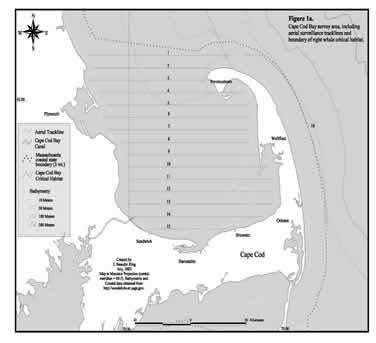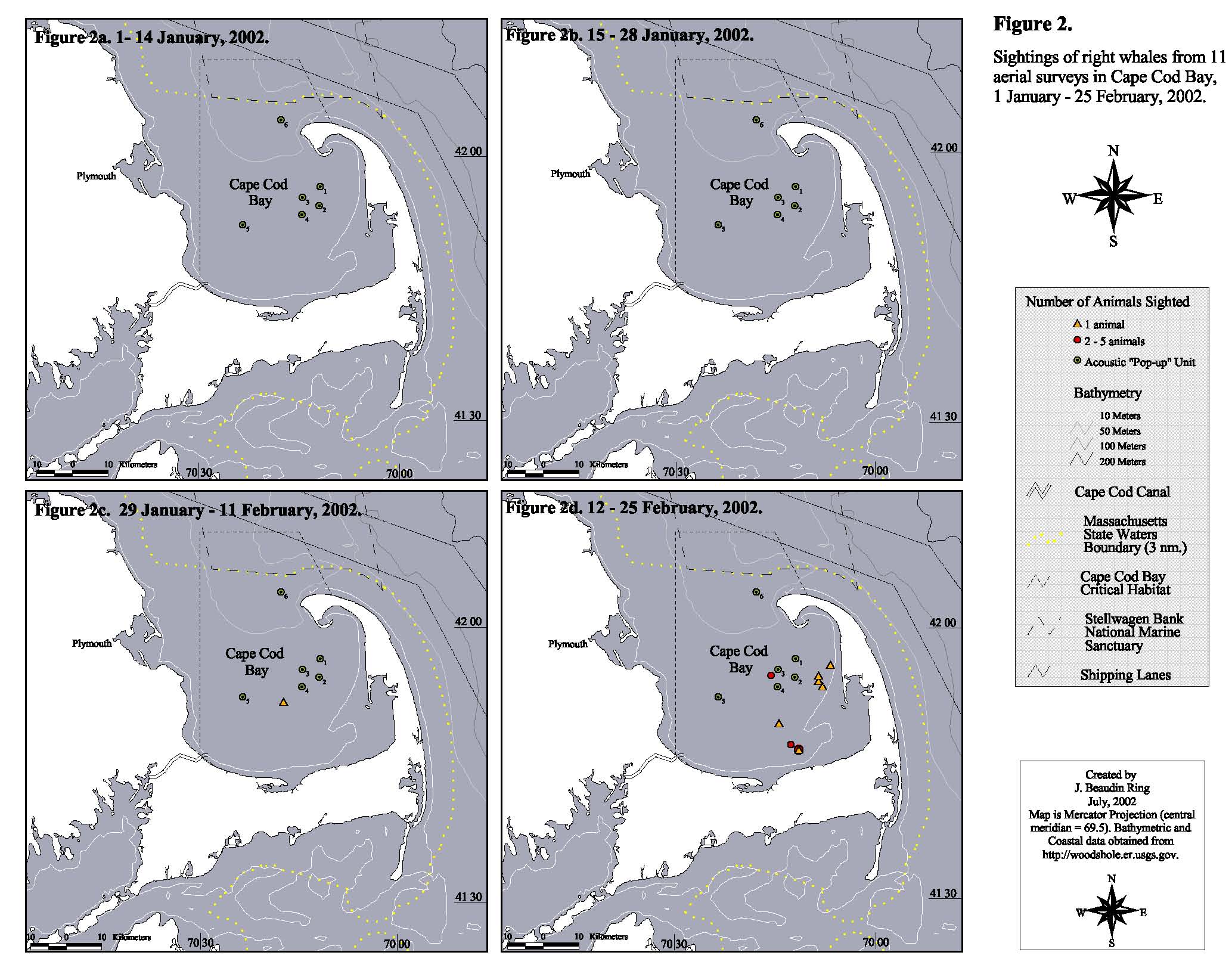Dataset: Right Whales aerial sightings in Cape Cod Bay and adjacent waters from the R/V Shearwater NEC-MB2002-1, 2002 (NEC-CoopRes project)
Co-Chief Scientist: Dr Charles Mayo (Provincetown Center for Coastal Studies)
Principal Investigator: Dr Moira Brown (Provincetown Center for Coastal Studies)
Principal Investigator: Dr Daniel McKiernan (Massachusetts Division of Marine Fisheries)
BCO-DMO Data Manager: Nancy Copley (Woods Hole Oceanographic Institution)
Program: NorthEast Consortium (NEC)
Project: Northeast Consortium: Cooperative Research (NEC-CoopRes)
Abstract
Right Whales aerial sightings in Cape Cod Bay and adjacent waters from the R/V Shearwater NEC-MB2002-1, 2002 (Northeast Consortium Cooperative Research project).
Surveillance, Monitoring, and Management of Right Whales and Habitat of Cape Cod Bay: 2002
Number of opportunistic marine mammal sightings and hours at sea during vessel-based habitat sampling cruises of Cape Cod Bay and adjacent waters, 2002
report: Surveillance, Monitoring and Management of North Atlantic Right Whales in Cape Cod Bay and Adjacent Waters - 2002 Final Report by Moira W. Brown, Owen C. Nichols, Marilyn K. Marx, and Jacqueline N. Ciano, Charles Mayo, Moriah Bessinger.
Executive Summary:
In 2002, from aerial and shipboard efforts in all areas combined, there were 139 sightings of right whales, of which 135 right whales were photographed and analyzed for this report. Of those 135 photographed sightings, 54 were from Cape Cod Bay and state waters along the outer coast of Cape Cod between Chatham and Provincetown (39 from aerial surveys and 15 from vessel cruises), 30 were from aerial surveys of Stellwagen Bank/Wildcat Knoll and 51 were from the Great South Channel.
To date, of the 135 photographed sightings, 48 of 54 (88%) in Cape Cod Bay and adjacent state waters and 21 of 30 (70%) in Stellwagen Bank/Wildcat Knoll have been matched to an individual right whale. The 54 sightings from Cape Cod Bay consisted of at least 24 different right whales. There were 18 right whales identified from aerial and vessel surveys and five additional whales that have yet to be matched, but that do not match any of the 18 animals plus one right whale photographed in the Cape Cod Canal on 15 April that was not seen during surveys. The 30 photographed sightings on Stellwagen Bank/Wildcat Knoll represent 29 different right whales of which 21 have been matched to an individual in the catalogue. Of note is one of the identified whales (# 1145), an adult female, which was seen with a calf. This mother calf pair was not recorded during any other surveys or on the calving ground in the southeast US. Our sighting of the calf brings the annual reproduction total for 2002 to 22 calves. Only one whale was seen on more than one occasion (#1424, an entangled right whale) and there remain eight individuals to be matched. There were 51 photographed sightings obtained in the two Great South Channel aerial surveys. Of those, only four whales, two mother calf pairs also seen on the calving, have been matched. The photographic matching process for the remaining sightings is still underway. None of the matches has undergone final confirmation by researchers the New England Aquarium. This will take place in the autumn of 2002. All sightings were reported upon completion of each survey to the National Marine Fisheries Service Sighting Advisory System. These aerial and vessel surveys are the principal source of right whale sightings for the NMFA/SAS in the winter months for waters in the northeast north of latitude 41°N.
Right whales were documented during aerial surveys of the Cape Cod Bay Critical Habitat area, in state waters west of the critical habitat and along the outer coast of Cape Cod between Chatham and Race Point for 37 days from 7 February to 15 March 2002. These visual sightings were augmented with passive acoustic monitoring in Cape Cod Bay. The bottom-mounted hydrophones recorded low levels of right whale calls from 24 December 2001 through April and early May. The results of the combined research efforts document right whale presence in Cape Cod Bay from late December through April into early May consistent with the results of the past four years. These data support the timing of existing management actions regarding gear restrictions.
The presence of right whales in nearby areas outside of the critical habitats of either Cape Cod Bay or the Great South Channel in 2002 and in past years suggests that a re-evaluation of the area protected by ESA Critical Habitat designation is needed and timely to adequately reflect the distribution and movements of right whales. The use of these areas such as the eastern portion of Stellwagen Bank and Wildcat Knoll has only come to light with the expanded survey efforts of the last five years. Since these areas are used for fishing activity and are transected by a major shipping lane between Boston and New York, consideration should be given to changing the boundaries of the neighboring Cape Cod Bay and Great South Channel Critical Habitats to include these areas of seasonal importance to right whales. We recommend that the data collected in the Stellwagen Bank/Wildcat Knoll area over the last five years be assessed using sightings-per-unit-of-effort analysis to determine the density and seasonality of right whale use and that the area be considered as a target for habitat sampling to assess the conditions of the food resource and for passive acoustic monitoring equipment to augment visual sightings.
(click maps to enlarge)
Related Datasets
No Related DatasetsRelated Publications
Mayo, C., Brown, M., McKiernan, D. (2009) Right Whales aerial sightings in Cape Cod Bay and adjacent waters from the R/V Shearwater NEC-MB2002-1, 2002 (NEC-CoopRes project). Biological and Chemical Oceanography Data Management Office (BCO-DMO). (Version 1) Version Date 2009-03-17 [if applicable, indicate subset used]. doi:10.1575/1912/bco-dmo.2988.1 [access date]
Terms of Use
This dataset is licensed under Creative Commons Attribution 4.0.
If you wish to use this dataset, it is highly recommended that you contact the original principal investigators (PI). Should the relevant PI be unavailable, please contact BCO-DMO (info@bco-dmo.org) for additional guidance. For general guidance please see the BCO-DMO Terms of Use document.


